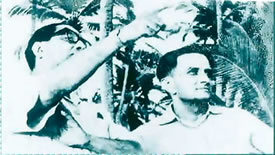
Dimdima
Online Children's Magazine from India

Dimdima
Online Children's Magazine from India
Why Thumba in Kerala was chosen as India's first rocket launching site?

When Dr Vikram Sarabhai, father of India’s space programme began to look for a suitable site for India’s first rocket launching facility in the early 1960s, his team zeroed in on Kerala. Why Kerala? The geomagnetic equator runs through the southern part of the state, and in those days scientists were eager to expand their knowledge of conditions obtaining in the upper reaches of the atmosphere above the geomagnetic equator. They were particularly interested in the equatorial electrojet, a system of electric currents prevalent there. The closer you are to the magnetic equator, the better placed you are to study the electrojet. At that time there were very few places in the world that were close to the magnetic equator and also had adequate infrastructure to support research of this sort. The government in Kerala was eager to have a space centre in the state and was ready to invest in infrastructure, so Sarabhai’s team set to work to look for suitable sites there. Eventually two were short-listed — one near Quilon (now Kollam) and the other near Trivandrum (now Thiruvananthapuram).
Sarabhai’s first choice was the site near Kollam, a place known as Vellana Thuruthu. He was struck by the natural beauty of the place and the fact that it was surrounded by no less than eight backwater lakes. If a rocket misfired and fell on land instead of the ocean it would fall in an uninhabited place. However, when he learnt that Vellana Thuruthu translated as ‘White Elephant Island’ he quickly changed his mind, knowing that white elephant (a phrase to indicate a possession that is troublesome to maintain) could become a national joke if something went wrong with the space programme. He opted for Thumba, which gets its name from a medicinal plant with white flowers which once grew in abundance there.
Thus, a sleepy, palm-fringed fishing village, near the southern tip of mainland India was catapulted into international fame on 21 November 1963 when a research rocket weighing 715 kilogram was launched into space from the Thumba Equatorial Rocket Launch Station situated there. The rocket soared to a height of 208 kilometres and released sodium vapour which lit up the Thumba evening sky. Even NASA scientists were impressed.
The Thumba Equatorial Rocket Launch Station from which our first rocket was launched was later re-named Vikram Sarabhai Space Centre in tribute to the man who propelled India into the Space Club, just seven years after the Soviet Union sent the world’s first satellite, Sputnik1 into space.
EXPLORE MORE...
Get Help or Give Help.
- Do you have a Science Question?
- Post it here and get the answer.
- Some questions posted by others are not yet answered.
- View those questions and answer them.
Dimdima is the Sanskrit word for ‘drumbeat’. In olden days, victory in battle was heralded by the beat of drums or any important news to be conveyed to the people used to be accompanied with drumbeats.
Bharatiya Vidya Bhavan
K. M Munshi Marg,
Chowpatty, Mumbai - 400 007
email : editor@dimdima.com
Bharatiya Vidya Bhavan
505, Sane Guruji Marg,
Tardeo, Mumbai - 400 034
email : promo@dimdima.com
Dimdima.com, the Children's Website of Bharatiya Vidya Bhavan launched in 2000 and came out with a Printed version of Dimdima Magazine in 2004. At present the Printed Version have more than 35,000 subscribers from India and Abroad.